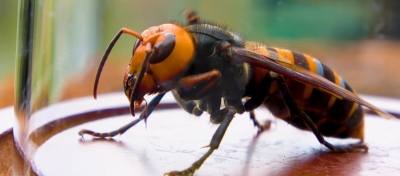
The Asian giant hornet is the largest hornet species in the world. Native to Southeast Asia and China, they can grow up to 2 inches long. As their sting can kill people, they are also called murder hornets. Considered an invasive pest, they pose a threat to the honeybee population.
The hornets like to create their nests by digging tunnels underground or using tunnels already dug by other animals. Their main sources of food are other larger insects, tree sap, and honey. Similar to the previously mentioned wasp species, Asian giant hornets also have a large stinger that contains a potent venom. If they sting something they usually release large amounts of venom, which can be lethal to humans if it occurs several times repeatedly. This is the reason why these wasps are often called murder hornets. Several Asian giant hornets were also spotted in the Pacific Northwest of North America, which caused mass panic because of how dangerous they can be. However, there were only several sightings and it is unclear whether more will continue to appear.
Asian Giant hornet are social wasps that build a new nest yearly underground in abandoned rodent burrows or sometimes in dead, hollow trunks or the roots of trees. Nests can house over 300 insects.
Similar to other social bees and wasps, the Asian giant hornet colonies are made up of one queen and non-reproductive female workers. In the springtime, queens will emerge from overwintering to feed and search for a suitable nesting site. She will build a nest, forage, lay eggs, and care for the young.
Once about 40 workers have reached adulthood, they take over foraging and caring for the colony, while the queen remains in the nest and lays eggs. At the end of summer, the queen will produce reproductive males and next year’s queen.
In the fall the males will leave the nest and wait outside the nest entrance for the new queen to emerge. When she emerges, males will ambush and mate with her. After mating, she will look for a place to overwinter until next spring.
Picture Credit : Google




